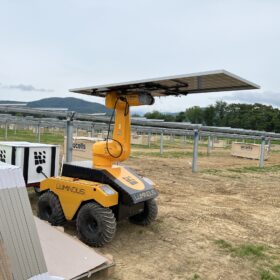West Australian energy trading technology firm Power Ledger has been going from strength to strength. Now the company’s signature peer-to-peer (P2P) trading technology is being installed in nine timber-based mixed-use developments in Perth’s east.
Power Ledger, in tandem with embedded network management business Element47, will integrate the P2P system into Bluerock Projects’ DeHavilland Apartments to allow nine households and one commercial space to share in the energy generation of a solar PV system and SENEC battery. The separate spaces will be able to share the solar energy between their SATEC advanced smart meters.
Power Ledger’s technology has already been used for projects as varied as the kind of residential trading scheme we’ll see at the DeHavilland Apartments, to a commercial project trading about 1MW of capacity between six commercial buildings in Bangkok.
Power Ledger Co-founder and Executive Chairman Dr Jemma Green said the project highlighted how the property industry could help drive institutional change towards new technologies and sustainable development. The DeHavilland Apartments are the first of their kind, a timber multi-residential, mixed-use medium-rise development in WA.
“The property industry, including developers, urban planners and architects are driving the communities of the future. Planning new technologies such as Power Ledger’s platform into new projects, developers are setting the foundations for the next generation of energy systems,” said Green.
“Power Ledger’s platform is emerging as a state-of-the-art technology for the homes of the future,” continued Green. “Homeowners are looking for greener energy solutions and Power Ledger not only enables greater use out of renewable infrastructure, it also enables solar owners to participate in energy trading markets that were previously unavailable to them.”
Power Ledger has already conducted a 40-customer P2P trial in Fremantle, WA, and announced a large-scale virtual power plant (VPP) in partnership with electricity wholesaler Powerclub, in South Australia.
Bluerock Projects Director Stuart Hawley similarly noted the movement of homeowners toward environmentally conscious purchases, specifically mentioning the integral part energy systems like that of Power Ledger play in the overall picture of the energy transition and future developments.
Working in conjunction with Power Ledger’s P2P technology, Element47’s technology monitors energy use in order to make sure the energy being consumed across the developments is being utilised effectively and ensuring the biggest solar pot from which to trade.
“Element47 gives homeowners greater control to reduce their energy costs,” said Element47 Chief Technical Officer Andrew Haning, “with Power Ledger’s platform allowing you to better utilise your building’s solar energy potential.”
Last month, following Power Ledger’s successful large-scale P2P trading trial in India (now set to expand), the Australian Energy Market Commission (AEMC) published a paper looking to Power Ledger as the kind of technology which could facilitate the Australian network’s expansion to a two-way street.
Green said the AEMC paper heralded “a new era of energy in Australia.”
The development is set for completion by the end of this year.
This content is protected by copyright and may not be reused. If you want to cooperate with us and would like to reuse some of our content, please contact: editors@pv-magazine.com.









5 comments
By submitting this form you agree to pv magazine using your data for the purposes of publishing your comment.
Your personal data will only be disclosed or otherwise transmitted to third parties for the purposes of spam filtering or if this is necessary for technical maintenance of the website. Any other transfer to third parties will not take place unless this is justified on the basis of applicable data protection regulations or if pv magazine is legally obliged to do so.
You may revoke this consent at any time with effect for the future, in which case your personal data will be deleted immediately. Otherwise, your data will be deleted if pv magazine has processed your request or the purpose of data storage is fulfilled.
Further information on data privacy can be found in our Data Protection Policy.